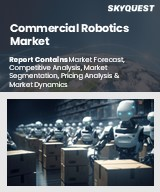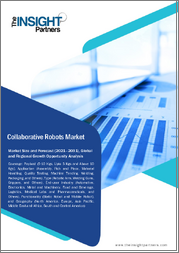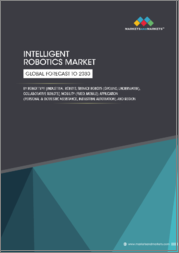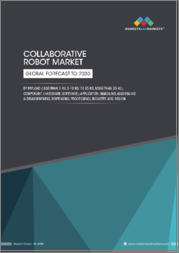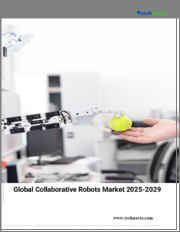
|
시장보고서
상품코드
1733382
세계의 협동 로봇(코봇) 시장 규모 : 페이로드별, 산업별, 용도별, 지역별 범위 및 예측Global Collaborative Robot (Cobot) Market Size By Payload (Up to 5 kg, More than 10 kg), By Industry (Automotive, Electronics, Metals), By Application (Handling, Automotive, Electronics), By Geographic Scope And Forecast |
||||||
협동 로봇(코봇) 시장 규모 및 전망
협동 로봇(코봇) 시장 규모는 2024년 42억 7,000만 달러로 평가되며, 2026-2032년 CAGR 40%로 성장하여 2032년에는 507억 6,000만 달러에 달할 것으로 예상됩니다.
협동 로봇은 코봇이라고도 불리며, 안전상의 이유로 보통 단독으로 작동되는 표준 산업용 로봇과 달리 공유된 작업 공간에서 인간 작업자와 함께 작업하는 로봇입니다. 코봇에는 첨단 센서, 소프트웨어, 안전 대책이 적용되어 조립, 포장, 품질 검사 등의 작업을 인간과 함께 수행할 수 있습니다. 사용자 친화적인 디자인, 프로그래밍의 용이성, 번거롭고 위험한 작업에서 인간을 보조하는 능력으로 인해 코봇은 현대 노동력의 필수적인 요소로 자리 잡았습니다.
코봇은 제조, 헬스케어, 물류, 농업 등 다양한 분야에서 도입이 진행되고 있습니다. 장비 유지보수, 자재 취급, 의료 환경에서의 정확한 시술 등의 업무를 지원합니다. 인공지능(AI), 머신러닝, IoT 통합의 발전으로 코봇의 미래는 낙관적인 것으로 보입니다.
자동화에 대한 수요가 증가하고 코봇이 더욱 지능적이고 적응력이 높아짐에 따라, 특히 유연성과 비용 효율성이 주요 장점인 중소기업(SME)에서의 활용이 증가할 것으로 예상됩니다. 협동 로봇 세계 시장은 다양한 부문에서 인간과 로봇의 협업과 생산성 향상을 나타내는 추세로 인해 크게 성장할 것으로 예상됩니다.
협동 로봇(코봇) 시장은 CAGR 40%로 성장하여 2032년 말까지 507억 6,000만 달러에 달할 것으로 추정됩니다.
주요 시장 촉진요인
중소기업의 채택 증가 : 유연성, 사용 편의성, 비용 효율성으로 인해 중소기업의 코봇 활용이 빠르게 확대되고 있습니다. 국제로봇연맹(IFR)에 따르면, 2019년 전 세계 코봇 설치는 11% 증가했으며, 이 증가의 대부분은 중소기업이 주도하고 있습니다.
유럽연합(EU)의 Horizon 2020 이니셔티브에 따라 실시된 연구에 따르면, 코봇은 중소기업의 생산성을 최대 25% 향상시키는 동시에 제조 비용을 20% 절감할 수 있다고 합니다. 이러한 증가의 원동력은 프로세스를 간소화하고, 인건비를 절감하며, 소규모 산업에서 효율성을 높일 수 있는 코봇의 잠재력입니다.
인더스트리 4.0과 스마트 제조의 확대 : 인더스트리 4.0과 스마트 제조의 확대는 코봇이 생산 공정의 자동화 및 최적화에 필수적이기 때문에 코봇 시장의 성장을 촉진하고 있습니다. 맥킨지 월드 인스티튜트(McKinsey World Institute)는 제조업의 IoT가 2025년까지 연간 7조 달러의 가치를 창출할 수 있으며, 코봇이 이러한 전환에 중요한 역할을 할 것으로 예상하고 있습니다. 독일 연방경제에너지부에 따르면, 제조업체의 83%가 인더스트리 4.0이 전체 가치사슬에 영향을 미칠 것으로 예상하고 있으며, 효율성 향상, 실시간 데이터 통합, 전체 생산 라인의 자동화 강화를 위해 코봇 도입이 증가할 것으로 예상하고 있습니다.
인간과 로봇의 안전한 협업에 대한 수요 증가 : 인간과 로봇의 안전한 협업에 대한 요구가 높아지면서 공유 작업 공간에서 보다 안전한 상호작용을 가능하게 하는 코봇이 코봇 산업을 주도하고 있습니다. 부상을 최대 72%까지 최소화할 수 있는 반면, 매사추세츠공과대학(MIT) 기계공학과의 연구에 따르면 인간과 로봇의 협업을 통해 단독으로 작업할 때보다 생산성이 85% 향상되는 것으로 밝혀졌습니다. 이러한 수요는 자동화를 중시하는 비즈니스에서 안전, 효율성, 인간과 로봇의 최적의 팀워크 향상에 대한 요구가 높아지고 있기 때문입니다.
주요 과제
노동력의 저항 : 협동 로봇(코봇)은 사람과 함께 일하는 것을 목적으로 하지만, 자동화에 대한 직원들의 반대는 여전히 큰 장벽으로 작용하고 있습니다. 직원들은 고용의 상실이나 직접 노동에서 감독으로의 직무 전환을 우려할 수 있습니다. 이는 사기 저하와 코봇 도입에 대한 반대를 불러일으켜 통합을 방해할 수 있습니다. 이 문제를 해결하기 위해 기업은 재교육에 힘쓰고, 코봇이 인간을 대체하는 것이 아니라 생산성을 향상시키는 도구로 인식할 수 있도록 협력적인 분위기를 조성해야 합니다.
규제 및 안전 준수 : 코봇이 인간과 함께 일하기 위해서는 높은 안전 및 규제 기준을 충족해야 하며, 이는 채용의 걸림돌이 될 수 있습니다. 각 지역마다 작업장 안전 및 자동화에 대한 요구사항이 다르기 때문에 채용 프로세스가 복잡해집니다. 특히 의료 및 자동차 제조와 같이 안전 프로토콜이 엄격한 산업에서 이러한 요구 사항을 준수하는 데 필요한 비용과 노력은 코봇의 통합을 지연시키거나 방해할 수 있습니다.
기존 로봇의 경쟁 압력 : 기존 산업용 로봇은 대규모 작업에서 더 나은 속도, 강도, 정밀도를 제공하며 자동차, 중공업 등의 산업을 계속 지배하고 있습니다. 코봇은 안전성과 유연성을 제공하는 반면, 일반 로봇에 비해 중작업 능력이 낮다고 여겨지는 경향이 있습니다. 이러한 경쟁 압력으로 인해 고속 및 대량 생산을 중시하는 기업에서는 아직 코봇이 요구되는 성능 기준을 충족하지 못할 수 있기 때문에 코봇의 도입이 제한되고 있습니다.
주요 동향
IoT와 인더스트리 4.0의 통합 : 사물인터넷(IoT)과 인더스트리 4.0 시스템에 코봇의 통합은 스마트 제조업을 더욱 빠르게 전개하고 있습니다. 클라우드 플랫폼에 연결된 코봇은 다른 기계와 통신하고, 실시간 데이터를 수집하고, 생산 공정을 자체적으로 최적화할 수 있습니다. 이러한 추세는 다운타임을 줄이고, 생산량을 늘리며, 보다 효율적이고 협업적인 생산 환경을 원하는 제조업체의 수요에 힘입은 것입니다. 스마트 팩토리의 출현으로 코봇은 완전 자동화 작업의 필수적인 구성요소가 되었습니다.
그리퍼 기술의 발전 : 그리퍼 기술의 발전은 코봇의 기능과 다재다능함을 향상시킵니다. 현재 코봇에는 보다 진보된 엔드 이펙터가 탑재되어 깨지기 쉬운 품목의 피킹, 복잡한 부품의 취급 등 섬세한 작업을 수행할 수 있게 되었습니다. 이러한 추세는 식품 가공, 제약, 전자기기 등 정확성과 섬세함이 요구되는 산업에서 코봇이 작동해야 할 필요성이 동기가 되고 있습니다. 그리퍼 기술의 향상으로 코봇이 다룰 수 있는 애플리케이션의 폭이 넓어지고 있습니다.
중소기업(SME)의 채택 증가 : 중소기업(SME)은 저렴한 비용, 사용 편의성, 소규모 생산 시설에 적합하다는 이유로 코봇의 활용을 늘리고 있습니다. 대규모 작업을 필요로 하는 일반 산업용 로봇과 달리 코봇은 유연하고 모듈화된 작업을 위해 만들어졌기 때문에 공간과 자원이 한정된 기업에 적합합니다. 이러한 추세는 세계 시장에서 경쟁력을 유지하고 인건비를 절감하기 위해 중소기업들이 자동화에 대한 수요를 높이고 있는 것이 그 배경입니다.
북미
북미는 첨단 자동차 산업과 높은 수준의 공장 자동화로 인해 협동 로봇(코봇) 시장을 선도하고 있습니다. 코봇은 조립 및 품질 검사 등의 부문에서 빠르게 활용되고 있으며, 자동차 산업의 큰 성장을 가져오고 있습니다. 국제로봇연맹(IFR)에 따르면, 미국 자동차 산업의 로봇 설치는 2021년에 19% 증가할 것으로 예상되며, 코봇은 이러한 성장에 중요한 역할을 할 것입니다. 제조 부문이 효율성을 높이기 위해 자동화를 도입하는 가운데, IFR은 2025년까지 북미의 로봇 설치량이 연간 8%의 성장률을 기록할 것으로 예상하고 있으며, 코봇이 중요한 역할을 할 것으로 예상하고 있습니다. 이러한 확대는 효율화의 필요성과 자동화를 통해 얻을 수 있는 경쟁 우위가 동기가 되고 있습니다.
A3에 따르면, 로봇 주문은 2022년 역대 최고치인 22% 증가하여 2021-2026년까지 연평균 41.8%, 총 190억 달러에 달할 것으로 예상되며, 2021-2026년 코봇 시장의 CAGR은 41.8%에 달할 것으로 예측됩니다. 미국 노동통계청과 미국 표준기술연구소는 코봇이 가져올 생산성 향상을 강조하고 있으며, 2030년까지 최대 20%까지 향상될 수 있다고 밝혔습니다.
2030년까지 210만 개의 일자리가 미충원될 것으로 예상되는 이 지역의 제조 기술 부족은 코봇 도입에 박차를 가하고 있습니다. 코봇은 노동력 부족에 대한 해결책이며, 개인의 기술 향상과 공급망에서 새로운 고용 가능성을 제공할 수 있는 능력을 갖추고 있어 향후 시장 성장을 뒷받침할 수 있을 것으로 보입니다.
아시아태평양
아시아태평양은 산업화, 인건비 상승, 자동화에 대한 정부의 강력한 지원 등의 이유로 협동 로봇(코봇) 시장에서 빠르게 성장하고 있습니다. 특히 중국은 산업 자동화를 장려하는 '메이드 인 차이나 2025' 정책 덕분에 압도적인 강세를 보이고 있습니다. 국제로봇연맹(IFR)에 따르면, 중국은 2013년 이후 가장 큰 산업용 로봇 시장으로 2020년까지 로봇 설치 대수가 20% 증가하고, 코봇이 중요한 역할을 할 것으로 예상되며, IFR은 2024년까지 전 세계 로봇 설치 대수의 70%를 아시아가 차지할 것으로 전망하고 있습니다. 중국이 그 대부분을 견인할 것으로 예측하고 있습니다. 이러한 급격한 증가는 제조 효율과 생산성 향상에 대한 요구가 원동력이 되고 있으며, 코봇은 산업 혁신에 필수적인 역할을 하고 있습니다.
아시아태평양 국가들은 제조 능력을 향상시키기 위해 코봇을 적극적으로 도입하고 있습니다. 싱가포르, 일본, 한국, 인도는 인력 부족을 완화하고 산업 생산량을 증가시키기 위해 코봇을 사용하고 있습니다. 싱가포르는 세계 최대의 산업용 로봇 밀도를 자랑하며, 일본과 한국은 중소기업(SME)의 코봇 도입을 확대하기 위한 국가 프로그램을 수립하고 있습니다. 인도의 '메이크 인 인디아' 추진도 자동화를 가속화하고 있으며, 인도의 산업용 로봇 시장은 비약적인 성장이 예상됩니다. 이러한 정부의 지원과 노동시장의 우려가 맞물려 아시아태평양 전체에서 코봇 도입이 진행되고 있으며, 아시아태평양 시장이 크게 개척되어 세계 제조업의 판도를 바꿀 준비가 되어가고 있습니다.
목차
제1장 협동 로봇(코봇) 세계 시장 소개
- 시장 개요
- 조사 범위
- 가정
제2장 주요 요약
제3장 VERIFIED MARKET RESEARCH 조사 방법
- 데이터 마이닝
- 검증
- 1차 자료
- 데이터 소스 리스트
제4장 협동 로봇(코봇) 세계 시장 전망
- 개요
- 시장 역학
- 성장 촉진요인
- 성장 억제요인
- 기회
- Porter's Five Forces 모델
- 밸류체인 분석
제5장 협동 로봇(코봇) 세계 시장 : 페이로드별
- 개요
- 5kg 이하
- 5 kg-10kg 이하
- 10kg 이상
제6장 협동 로봇(코봇) 세계 시장 : 산업별
- 개요
- 자동차
- 일렉트로닉스
- 금속
- 식품 및 음료
제7장 협동 로봇(코봇) 세계 시장 : 용도별
- 개요
- 핸들링
- 조립·분해
- 용접과 솔더링
- 디스펜싱
- 기타
제8장 협동 로봇(코봇) 세계 시장 : 지역별
- 개요
- 북미
- 미국
- 캐나다
- 멕시코
- 유럽
- 독일
- 영국
- 프랑스
- 기타 유럽
- 아시아태평양
- 중국
- 일본
- 인도
- 기타 아시아태평양
- 기타
- 라틴아메리카
- 중동 및 아프리카
제9장 세계의 협동 로봇(코봇) 시장 경쟁 구도
- 개요
- 각사의 시장 순위
- 주요 개발 전략
제10장 기업 개요
- Universal Robots
- Techman Robot
- FANUC
- KUKA
- Doosan Robotics
- AUBO Robotics
- ABB
- YASKAWA
- Precise Automation
- Rethink Robotics
제11장 주요 개발
- 제품 출시/개발
- 인수합병
- 사업 확대
- 파트너십과 제휴
제12장 부록
- 관련 조사
Collaborative Robot (Cobot) Market Size And Forecast
Collaborative Robot (Cobot) Market size was valued at USD 4.27 Billion in 2024 and is projected to reach USD 50.76 Billion by 2032, growing at a CAGR of 40% from 2026 to 2032.
Collaborative robots, also known as cobots, are robots meant to work alongside human operators in a shared workspace, as opposed to standard industrial robots, which are normally operated in isolation for safety reasons. Cobots are outfitted with advanced sensors, software, and safety measures that allow them to work alongside humans while completing activities like as assembly, packing, and quality inspection. Their user-friendly design, ease of programming, and capacity to aid humans in tedious or risky jobs make them an indispensable component of the modern workforce.
Cobots are increasingly being employed in a variety of areas, including manufacturing, healthcare, logistics, and agriculture. They help with duties such as equipment maintenance, material handling, and accuracy procedures in healthcare environments. The future of cobots seems optimistic, thanks to advances in artificial intelligence (AI), machine learning, and IoT integration.
As the demand for automation grows and cobots become more intelligent and adaptive, their use is projected to increase, particularly in small and medium-sized businesses (SMEs), where their flexibility and cost-effectiveness are key advantages. The global market for cobots is expected to grow significantly, with trends indicating increased human-robot collaboration and productivity in a variety of areas.
Collaborative Robot (Cobot) Market is estimated to grow at a CAGR of 40% & reach US$ 50.76 Bn by the end of 2032
Key Market Drivers:
Increasing Adoption in Small and Medium-Sized Enterprises (SMEs): Cobot use among small and medium-sized organizations (SMEs) is fast expanding due to its flexibility, ease of use, and cost-effectiveness. According to the International Federation of Robotics (IFR), global cobot installations increased by 11% in 2019, with SMEs driving the majority of this rise.
According to research conducted under the European Union's Horizon 2020 initiative, cobots can increase SME productivity by up to 25% while lowering manufacturing costs by 20%. This rise is being driven by cobots' potential to streamline processes, cut personnel costs, and increase efficiency in smaller-scale industrial contexts.
Expansion of Industry 4.0 and Smart Manufacturing: The growth of Industry 4.0 and smart manufacturing is driving cobot market growth, as cobots are essential for automating and optimizing production processes. The McKinsey Global Institute believes that IoT in manufacturing could produce up to USD 7 Trillion per year by 2025, with cobots playing a critical part in this transition. According to the German Federal Ministry for Economic Affairs and Energy, 83% of manufacturers expect Industry 4.0 to influence the whole value chain, increasing cobot adoption for better efficiency, real-time data integration, and enhanced automation across production lines.
Growing Demand for Safe Human-Robot Collaboration: The increased demand for secure human-robot cooperation is driving the cobot industry since cobots allow for safer interactions in shared workspaces. According to OSHA, deploying cobots in manufacturing can minimize worker injuries by up to 72%, while a study from MIT's Department of Mechanical Engineering discovered that human-robot collaboration increases productivity by 85% when compared to working alone. This demand stems from the requirement for increased safety, efficiency, and optimal teaming between humans and robots in automation-focused businesses.
Key Challenges:
Workforce Resistance: Although collaborative robots (cobot) are intended to operate alongside people, employee opposition to automation remains a significant barrier. Employees may be concerned about job losses or the transition in their function from direct labor to supervision. This can lead to poorer morale and opposition to the adoption of cobots, impeding their integration. To address this issue, businesses must engage in reskilling and creating a collaborative atmosphere in which humans regard cobots as tools that improve productivity rather than replace them.
Regulatory and Safety Compliance: Cobots must meet high safety and regulatory criteria to work with humans, which can be a hurdle to adoption. Different locations have different requirements for workplace safety and automation, complicating the adoption process. The expense and effort required to achieve compliance with these requirements can delay or prevent the integration of cobots, especially in industries with stringent safety protocols, such as healthcare or automotive manufacturing.
Competitive Pressure from Traditional Robots: Traditional industrial robots, which provide better speed, strength, and precision in large-scale operations, continue to dominate industries such as automotive and heavy manufacturing. While cobots provide safety and flexibility, they are frequently thought to be less capable of heavy-duty jobs than regular robots. This competitive pressure limits the implementation of cobots in businesses that value high-speed, high-volume production, as cobots may not yet match the required performance standards.
Key Trends:
IoT and Industry 4.0 Integration: The integration of cobots into the Internet of Things (IoT) and Industry 4.0 systems is hastening the deployment of smart manufacturing. Cobots connected to cloud platforms may communicate with other machines, collect real-time data, and optimize production processes on their own. This trend is being pushed by manufacturers' demand for more efficient, linked production environments that reduce downtime and improve output. The advent of smart factories has made cobots an essential component in fully automated operations.
Advancements in Gripper Technology: Advancements in gripper technology improve the functionality and versatility of cobots. Cobots now have more advanced end-effectors, allowing them to perform delicate jobs such as picking fragile items or handling complex components. This trend is motivated by the necessity for cobots to operate in industries that need accuracy and delicacy, such as food processing, medicines, and electronics. Improved gripper technology broadens the range of applications that cobots can handle.
Rising Adoption in Small and Medium-Sized Enterprises (SMEs): Small and medium-sized enterprises (SMEs) are increasingly using cobots due to their low cost, ease of usage, and suitability to smaller production facilities. Unlike typical industrial robots, which require large-scale operations, cobots are built for flexible and modular jobs, making them appropriate for enterprises with limited space and resources. This trend is being driven by SMEs' increased demand for automation to stay competitive in the global market and decrease labor expenses.
North America:
The North American region leads the collaborative robot (Cobot) Market, owing to its advanced automotive industry and high levels of factory automation. Cobots are rapidly being used in areas like as assembly and quality inspection, resulting in substantial growth in the automobile industry. According to the International Federation of Robotics (IFR), robot installations in the US automotive industry will expand by 19% in 2021, with cobots playing a critical part in this growth. As manufacturing sectors embrace automation to boost efficiency, the IFR forecasts an 8% annual growth rate for robot installations in North America by 2025, with cobots playing a significant role. This expansion is motivated by the need for efficiency and the competitive advantage afforded by automation.
Cobots are being embraced across North America's manufacturing landscape, not just in the automotive industry. According to A3, robot orders would climb by a record 22% in 2022, with a projected CAGR of 41.8% for the cobot market from 2021 to 2026, with a total value of USD 19 Billion. The United States Bureau of Labor Statistics and the National Institute of Standards and Technology emphasize the productivity boost that cobots can provide, with potential improvements of up to 20% by 2030.
The region's rising manufacturing skills deficit, which is expected to leave 2.1 million positions unfilled by 2030, is fueling cobot adoption. Cobots are viewed as a solution to labor shortages, with the ability to upskill individuals and provide new job possibilities in the supply chain, hence supporting future market growth.
Asia Pacific:
The Asia-Pacific region, is rapidly expanding in the collaborative robot (Cobot) Market, owing to reasons such as industrialization, growing labor costs, and strong government backing for automation. China, in particular, is a dominant power thanks to its "Made in China 2025" policy, which encourages industrial automation. According to the International Federation of Robotics (IFR), China has been the largest industrial robot market since 2013, and its robot installations will increase by 20% by 2020, with cobots playing a critical role. The IFR predicts that Asia will account for 70% of worldwide robot installations by 2024, with China driving the majority of this expansion. This spike is driven by the need for enhanced manufacturing efficiency and productivity, hence cobots are vital in transforming industries.
Asia-Pacific countries are aggressively implementing cobots to improve manufacturing capacities. Singapore, Japan, South Korea, and India are using cobots to alleviate manpower difficulties and increase industrial output. Singapore has the world's largest industrial robot density, while Japan and South Korea have established national programs to increase cobot adoption in small and medium-sized firms (SMEs). India's "Make in India" push is also accelerating automation, with the Indian industrial robots market expected to expand dramatically. These government-backed initiatives, together with labor market concerns, are driving cobot adoption throughout the region, preparing the Asia-Pacific market for significant development and altering the global manufacturing scene.
Global Collaborative Robot (Cobot) Market: Segmentation Analysis
The Global Collaborative Robot (Cobot) Market is Segmented on the basis of Payload, End-User Industry, Application, And Geography.
Collaborative Robot (Cobot) Market, By Payload
- Up to 5 kg
5-10 kg
- More than 10 kg
Based on Payload, the market is fragmented into Up to 5 kg, 5-10 kg, and More than 10 kg. The up to 5 kg category dominates due to its broad use in light manufacturing operations like assembling, packaging, and material handling. These cobots are popular among small and medium-sized businesses (SMEs) due to their simplicity of integration and cost-effectiveness. The More than 10 kg segment is the fastest-growing, owing to rising demand for larger payload capabilities in industries such as automotive and aerospace, where cobots are already doing more difficult jobs like welding and heavy lifting.
Collaborative Robot (Cobot) Market, By End-User Industry
- Automotive
- Electronics
- Metals
- Food & Beverages
Based on End-User Industry, the market is segmented into Automotive, Electronics, Metals, and Food & Beverages. The automotive segment is the leading force, owing to the industry's considerable automation requirements for jobs like assembly, painting, and quality inspection. This industry has a long history of using robotics to improve efficiency and lower labor costs. The Food & Beverages segment is the fastest-growing, driven by rising demand for automation in packaging, sorting, and quality control processes to meet stringent hygiene standards and high production rates. The fast rise of e-commerce, as well as changing consumer tastes for packaged foods, are driving the implementation of cobots in this industry.
Collaborative Robot (Cobot) Market, By Application
- Handling
- Automotive
- Electronics
- Plastics and Polymers
- Furniture and Equipment
Based on Application, the market is segmented into Handling, Automotive, Electronics, Plastics and Polymers, Furniture and Equipment. The handling segment is the most popular, as cobots are widely employed in manufacturing and logistics for a variety of tasks like as pick-and-place, material handling, and palletization. Their adaptability and capacity to collaborate with human operators without safety boundaries make them in great demand across a wide range of sectors. The fastest-growing segment is electronics, which is being driven by rising demand for automation in the production of electronic components including circuit boards and consumer electronics. The rise of smart devices, combined with the necessity for precision in assembly processes, is driving the growing adoption of cobots in this area, allowing for increased efficiency and productivity in electronics manufacturing.
Collaborative Robot (Cobot) Market, By Geography
- North America
- Europe
- Asia Pacific
- Rest of the World
- On the basis of Geography, the Global Collaborative Robot (Cobot) Market is classified into North America, Europe, Asia Pacific, and the Rest of the World. North America currently dominates the collaborative robot market, owing to its large automotive industry and innovative production methods. The Asia-Pacific region, notably China, is experiencing the quickest development due to rapid industrialization, rising labor costs, and government support for automation efforts.
Key Players
The "Global Collaborative Robot (Cobot) Market" study report will provide valuable insight with an emphasis on the global market. The major players in the market Universal Robots, Techman Robot, FANUC, KUKA, Doosan Robotics, AUBO Robotics, ABB, YASKAWA, Precise Automation, Rethink Robotics. The competitive landscape section also includes key development strategies, market share, and market ranking analysis of the above-mentioned players globally.
Our market analysis also entails a section solely dedicated to such major players wherein our analysts provide an insight into the financial statements of all the major players, along with product benchmarking and SWOT analysis. The competitive landscape section also includes key development strategies, market share, and market ranking analysis of the above-mentioned players globally.
- Collaborative Robot (Cobot) Market Recent Developments
- In July 2023, Collaborative Robotics raised $30 million in its Series A round with the goal of advancing the development and deployment of new cobots.
- In May 2023, Universal Robots and Denali Advanced Integration formed a cooperation to provide customers with unique collaborative robotics solutions.
TABLE OF CONTENTS
1 INTRODUCTION OF GLOBAL COLLABORATIVE ROBOT (COBOT) MARKET
- 1.1 Overview of the Market
- 1.2 Scope of Report
- 1.3 Assumptions
2 EXECUTIVE SUMMARY
3 RESEARCH METHODOLOGY OF VERIFIED MARKET RESEARCH
- 3.1 Data Mining
- 3.2 Validation
- 3.3 Primary Interviews
- 3.4 List of Data Sources
4 GLOBAL COLLABORATIVE ROBOT (COBOT) MARKET OUTLOOK
- 4.1 Overview
- 4.2 Market Dynamics
- 4.2.1 Drivers
- 4.2.2 Restraints
- 4.2.3 Opportunities
- 4.3 Porters Five Force Model
- 4.4 Value Chain Analysis
5 GLOBAL COLLABORATIVE ROBOT (COBOT) MARKET, BY PAYLOAD
- 5.1 Overview
- 5.2 Up to 5 kg
- 5.3 5-10 kg
- 5.4 More than10 kg
6 GLOBAL COLLABORATIVE ROBOT (COBOT) MARKET, BY END-USER INDUSTRY
- 6.1 Overview
- 6.2 Automotive
- 6.3 Electronics
- 6.4 Metals
- 6.5 Food & Beverages
7 GLOBAL COLLABORATIVE ROBOT (COBOT) MARKET, BY APPLICATION
- 7.1 Overview
- 7.2 Handling
- 7.3 Assembling and Disassembling
- 7.4 Welding and Soldering
- 7.5 Dispensing
- 7.6 Others
8 GLOBAL COLLABORATIVE ROBOT (COBOT) MARKET, BY GEOGRAPHY
- 8.1 Overview
- 8.2 North America
- 8.2.1 U.S.
- 8.2.2 Canada
- 8.2.3 Mexico
- 8.3 Europe
- 8.3.1 Germany
- 8.3.2 U.K.
- 8.3.3 France
- 8.3.4 Rest of Europe
- 8.4 Asia Pacific
- 8.4.1 China
- 8.4.2 Japan
- 8.4.3 India
- 8.4.4 Rest of Asia Pacific
- 8.5 Rest of the World
- 8.5.1 Latin America
- 8.5.2 Middle East And Africa
9 GLOBAL COLLABORATIVE ROBOT (COBOT) MARKET COMPETITIVE LANDSCAPE
- 9.1 Overview
- 9.2 Company Market Ranking
- 9.3 Key Development Strategies
10 COMPANY PROFILES
- 10.1 Universal Robots
- 10.1.1 Overview
- 10.1.2 Financial Performance
- 10.1.3 Product Outlook
- 10.1.4 Key Developments
- 10.2 Techman Robot
- 10.2.1 Overview
- 10.2.2 Financial Performance
- 10.2.3 Product Outlook
- 10.2.4 Key Developments
- 10.3 FANUC
- 10.3.1 Overview
- 10.3.2 Financial Performance
- 10.3.3 Product Outlook
- 10.3.4 Key Developments
- 10.4 KUKA
- 10.4.1 Overview
- 10.4.2 Financial Performance
- 10.4.3 Product Outlook
- 10.4.4 Key Developments
- 10.5 Doosan Robotics
- 10.5.1 Overview
- 10.5.2 Financial Performance
- 10.5.3 Product Outlook
- 10.5.4 Key Developments
- 10.6 AUBO Robotics
- 10.6.1 Overview
- 10.6.2 Financial Performance
- 10.6.3 Product Outlook
- 10.6.4 Key Developments
- 10.7 ABB
- 10.7.1 Overview
- 10.7.2 Financial Performance
- 10.7.3 Product Outlook
- 10.7.4 Key Developments
- 10.8 YASKAWA
- 10.8.1 Overview
- 10.8.2 Financial Performance
- 10.8.3 Product Outlook
- 10.8.4 Key Developments
- 10.9 Precise Automation
- 10.9.1 Overview
- 10.9.2 Financial Performance
- 10.9.3 Product Outlook
- 10.9.4 Key Developments
- 10.10 Rethink Robotics
- 10.10.1 Overview
- 10.10.2 Financial Performance
- 10.10.3 Product Outlook
- 10.10.4 Key Developments
11 KEY DEVELOPMENTS
- 11.1 Product Launches/Developments
- 11.2 Mergers and Acquisitions
- 11.3 Business Expansions
- 11.4 Partnerships and Collaborations
12 Appendix
- 12.1 Related Research







